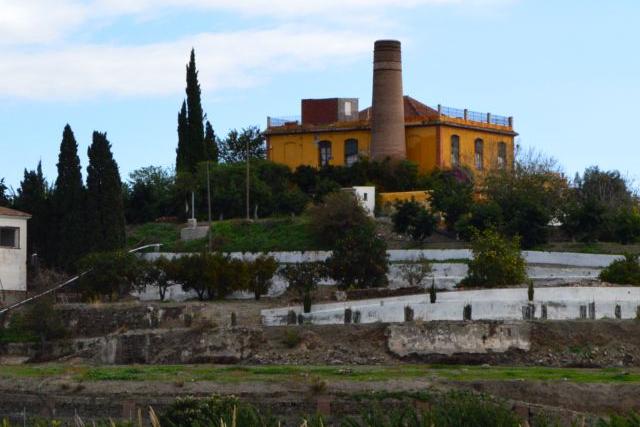The ancient mills and sugar factories were located in the vicinity of the canals due to the necessity of water in the process of sugar, flour or paper manufacturing. This type of construction comes from the Arabian period, using a dam made of trunks and masonry in the area of Tajo de los Vados. From this place in direction S-SE, it passed through the agricultural plain of Pataura following the current canal way through Minasierra and the south part of the villa until the rambla de los Álamos.
The display of the agricultural landscape around the irrigation canal and its branches let the introduction of the sugar cane harvest in the agricultural plain of Guadalfeo river from the 10th century.
At the end of the 16th century is when the sugar cane production was at its peak, becoming single crop farming in the area with more than 10,000 marjales (the local unit of measure equivalent to 5,280,000 m2). The effect of this sugar cane production was clearly seen in the landscape and organisation of the crops, where the subsistence crops were set aside. The consequence of getting wood for the factories was even worst for the landscape.
During the 18th century, the traditional sugar cane manufacturing process went into crisis which led to an incredible transformation of the agricultural plain and an important redistribution of the lands. As a consequence, almost the whole sugar cane crops disappeared and were replaced at the beginning of 1800 by cotton crops.
At the end of the 40s, the sugar cane manufacture came back thanks to the up-dating of the machinery with the use of the steam as the main force to make the mills work, the evaporation in a vacuum and the boiling processes as well as the use of turbines to purge. The whole development and use of these methods made the productivity grow and resulted in the return of the sugar cane production as single crop farming in the agricultural plain.
This journey starts from the Ntra. Sra. Del Pilar Sugar Factory in direction to the path of Minasierra. The whole trail goes along this pathway until you reach a split. Then, if you take the left path, you will head back towards the Ntra. Sra. Del Pilar Sugar Factory, ending the route. However, if you take the right path you will begin the hiking trail called “Cultivos subtropicales” (Subtropical Crops).
Ntra. Sra. Del Pilar Sugar Factory. Built in 1882 by the Burgos, Domínguez and García commercial entity which was mainly constituted by Mr. José de Burgos Real, a landowner and resident in Motril who belonged to a family related to the sugar cane tradition; Mrs. Pilar de León y Gregorio, marchioness of Squilacce and; the brothers Antonio, Pedro and Juan Domínguez de Gregorio, businessmen and owners from Granada who traded with the sugar cane in the agricultural plain of Granada. In 1883, the factory began its first milling season. Then, in 1903 the Ntra. Sra. Del Pilar sugar factory became part of the Sugar Factory Society in Spain. A lot of sugar factories started to be shut down by the Society and only the most profitable were let open. Therefore, the production process was focused on the ones that remained open, leading to a modernisation of the machinery at the end of 1920s. This included the Ntra. Sra. Del Pilar sugar factory which was quite important and milled around a third of the sugar cane harvest in the agricultural plain of the Guadalfeo river. This building together with the Hispania sugar factory in Málaga became the greatest and most important duo controlled by the Society. In 1984 it finally was closed down.
Nowadays, the administration office, the drying area and the warehouse are the best preserved. However, the working-class neighbourhood was nearly totally destroyed few years ago.
San Luis Factory. The owner of this small building was Luis Vinuesa Molina who built it in 1910. He was a lawyer and the major of Motril during the first years of the century. Due to the fact that in 1904 the Sugar Factory Society in Spain began a policy to close down most of the sugar factories located in the area, a conflict between the agricultural owners and the Society started. Therefore, the construction of San Luis Factory was a consequence of this fact. From 1905, local farmers had some initiatives to build its own factories because of the control that the Society applied in most of the facilities as well as in the price policy in the raw material which was clearly a great disadvantage for farmers. The factory had different owners until it finally closed down in 1987.
At present, it is a derelict factory.
La Almudena Factory. Built in 1912 by Mr. José de Burgos and his wife Almudena Martel to grill the canes which were grown in their lands. In 1930 it stopped working as a sugar factory and changed its function in the 1980s, when it was used as a warehouse and a place for the bottling process by the Arehucas Distilleries. During the last years, their industrial facilities and chimneys have been restored and used for hostelry business.
El Candelón Grande o Canalón Grande. It was originally built in 1848 upon the remains of a previous one, when Mr. Antonio Mantilla was the major of the town. Its main purpose was to use the water from the main canal for irrigating the surrounding lands.
The Ntra. Sra. Del Pilar Sugar Factory, located around 300 metres (984.25 feet) in direction to the north from the roundabout of Motril.
You will have to arrive at the house of La Almudena and head back towards the Ntra. Sra. Del Pilar Sugar Factory following an alternative route.
There is an option to end the route of “Fábricas azucareras” (Sugar Factories) connecting to the path called “Cultivos subtropicales” (Subtropical Crops) which ends in the Cortijo de los Bates.


